In today’s digital age, having a robust online presence is no longer a luxury—it’s a necessity, even for traditional businesses like tailoring services. A well-crafted website can transform your local shop into a thriving online hub, attracting new customers and retaining existing ones. But where do you begin? The answer often lies in finding the right web designer, and ideally, one that’s affordable. This article will guide you through the world of web design for tailoring services, ensuring you get the best online representation without breaking the bank.
Quick Summary:
- Websites are essential for tailors to grow and build trust.
- Find affordable web designers with good skills and clear communication.
- Ensure your tailoring website is mobile-friendly and SEO-optimized.
- Explore freelancers, students, or DIY options for budget-friendly design.
Table of Contents
- Why Tailoring Services Need a Website: Beyond the Needle and Thread
- Expanding Your Customer Reach: From Local to Global
- Building Credibility and Trust: The Digital Trust Factor
- Streamlining Operations and Communication: The Modern Tailor
- Marketing and Growth: Sewing Seeds for Success
- What to Look for in an Affordable Web Designer: The Right Fit
- Skills and Experience: Crafting a Perfect Fit
- Communication and Collaboration: Sewing Together Your Ideas
- Pricing and Payment Options: Budget-Friendly Choices
- Additional Services and Support: The Full Package
- Types of Websites Ideal for Tailoring Services: Stitching Your Digital Fabric
- Basic Informational Website: A Simple and Effective Start
- Portfolio Website: Showcasing Your Artistry
- E-Commerce Website: Expanding Your Business Online
- Combined Website: The Hybrid Approach
- The Web Design Process for Tailoring Services: A Step-by-Step Guide
- Step 1: Initial Consultation and Planning: Laying the Foundation
- Step 2: Design and Mock-Ups: Visualizing Your Vision
- Step 3: Development and Testing: Bringing Your Website to Life
- Step 4: Launch and Promotion: Making Your Website Go Live
- Step 5: Maintenance and Support: Keeping Your Website in Shape
- Optimizing Your Website for Search Engines: The SEO Stitch
- Keyword Research: Understanding Your Search Terms
- On-Page Optimization: Refining Your Website’s Content
- Off-Page Optimization: Building Your Website’s Reputation
- Mobile Optimization: Ensuring Your Website’s Accessibility
- Analytics and Monitoring: Measuring Your Success
- Strategies for Finding Affordable Web Designers: The Right Path
- Freelance Platforms: The Gig Economy
- Local Web Design Agencies: Local Expertise
- Student Designers: Cost-Effective Options
- Web Design Software and DIY Options: Doing It Yourself
- Referral Programs: Leveraging Your Network
- Qrolic Technologies: Your Partner in Digital Excellence
- Why Choose Qrolic Technologies?
- How Qrolic Technologies Can Help Your Tailoring Business
- The Future of Web Design for Tailoring Services: Embracing Innovation
- Enhanced User Experience: The Future of Interaction
- AI-Powered Solutions: The Rise of Smart Websites
- Voice Search Optimization: Talking to Your Website
- Augmented Reality (AR) and Virtual Reality (VR): Immersive Experiences
- Conclusion: Stitching Together Your Online Success
Why Tailoring Services Need a Website: Beyond the Needle and Thread
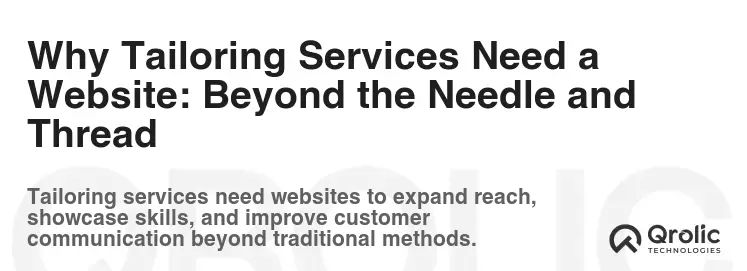
Before diving into the “how,” let’s understand the “why.” Why does your tailoring business need a website? Here’s a comprehensive look at the benefits:
Expanding Your Customer Reach: From Local to Global
- Local Visibility: A website with local SEO optimization ensures that when people in your area search for “tailoring services near me,” your business pops up. This is crucial for attracting new local customers who might not be aware of your shop.
- Beyond Geographical Limits: With the internet, you are not limited to your local clientele. You can serve customers from different cities or even countries, especially if you offer specialized services or unique tailoring expertise.
- 24/7 Availability: Unlike your physical store, your website is always open, allowing potential clients to browse your services, check your portfolio, and contact you at their convenience.
Building Credibility and Trust: The Digital Trust Factor
- Professional Image: A well-designed website projects professionalism, making your tailoring service look more legitimate and trustworthy. This is especially important in a field where reputation is critical.
- Showcasing Your Portfolio: You can display high-quality images of your best work. Showcasing your portfolio demonstrates your skills and capabilities, giving potential customers the confidence to choose your service.
- Testimonials and Reviews: Websites allow you to feature customer reviews and testimonials, which can significantly influence a customer’s decision. Positive feedback provides social proof and builds trust.
Streamlining Operations and Communication: The Modern Tailor
- Online Booking and Appointments: Allow customers to book appointments online through your website, reducing the need for phone calls and streamlining your scheduling process.
- Service Details and Pricing Transparency: Clearly list the services you offer and their corresponding prices. This transparency can improve customer satisfaction and reduce misunderstandings.
- Faster Communication: A contact form on your website makes it easy for customers to send inquiries or ask questions. You can respond promptly, enhancing customer service.
Marketing and Growth: Sewing Seeds for Success
- SEO and Organic Traffic: A well-optimized website can attract organic traffic through search engines like Google. This means people actively looking for tailoring services will find you without having to rely solely on paid ads.
- Email Marketing Opportunities: Collect email addresses through your website and send newsletters or special offers to your subscribers, keeping them engaged and informed about your services.
- Analytics and Tracking: Website analytics tools allow you to track website traffic, understand user behavior, and measure the effectiveness of your marketing efforts.
What to Look for in an Affordable Web Designer: The Right Fit
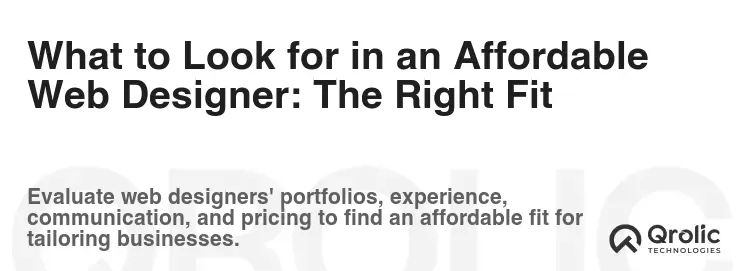
Finding the right web designer for your tailoring services doesn’t have to be a daunting task. Here’s what to look for, particularly when on a budget:
Skills and Experience: Crafting a Perfect Fit
- Portfolio Review: Always ask to see examples of their previous work, especially projects that resemble what you need for your tailoring business. Evaluate the design quality, functionality, and overall aesthetic.
- Understanding of the Industry: While not mandatory, it’s beneficial if the web designer understands the tailoring industry. This enables them to design a website that resonates with your target audience.
- Technical Expertise: Ensure they are skilled in various aspects of web design, including HTML, CSS, Javascript, and responsive design principles (ensuring your site looks great on all devices).
Communication and Collaboration: Sewing Together Your Ideas
- Clear Communication: A good web designer should be able to clearly explain the design process, answer your questions, and keep you updated on progress.
- Open to Feedback: They should be willing to listen to your feedback and incorporate your suggestions into the design. This collaborative approach is crucial for creating a website that truly represents your brand.
- Timely Responses: Responsiveness is key. Your web designer should be prompt in their replies and keep you informed about any delays or issues.
Pricing and Payment Options: Budget-Friendly Choices
- Transparent Pricing: Look for a web designer who provides a clear breakdown of costs and doesn’t have hidden fees. A detailed quote is vital for proper budget planning.
- Flexible Payment Plans: Some web designers offer payment plans or installments, which can help you manage the cost effectively. Inquire about such options.
- Value for Money: Don’t just focus on the cheapest option; look for the best value—quality web design at a reasonable price. Consider the long-term benefits of investing in a good site.
Additional Services and Support: The Full Package
- SEO Optimization: Ensure the web designer understands SEO principles and can optimize your website for search engines. This will increase your online visibility.
- Mobile-Friendly Design: A responsive design that adapts to all devices is non-negotiable. Check that your site will work on smartphones, tablets, and desktops.
- Ongoing Maintenance: Some web designers offer maintenance services. Ensure your website is up-to-date and functioning correctly.
Types of Websites Ideal for Tailoring Services: Stitching Your Digital Fabric
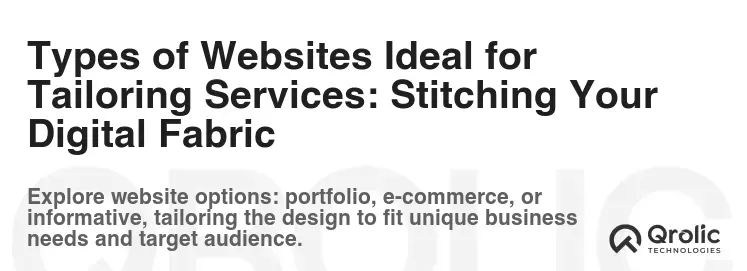
Several types of websites can work well for tailoring services. Here are some options to consider:
Basic Informational Website: A Simple and Effective Start
- Features: This type of website primarily focuses on providing essential information about your business, including your services, contact details, operating hours, and a brief “About Us” section.
- Benefits: It’s a simple and cost-effective way to establish an online presence. Ideal for smaller tailoring services with limited budgets.
- Best for: Tailors who are just starting out or want a basic online listing of their services.
Portfolio Website: Showcasing Your Artistry
- Features: This website focuses on displaying your work. Include high-quality images and detailed descriptions of your tailored garments, including before-and-after shots.
- Benefits: It’s perfect for attracting customers by showcasing your skills and creativity. Great for specialized tailoring, custom designs, and high-end services.
- Best for: Tailors who want to display their expertise and style to potential customers.
E-Commerce Website: Expanding Your Business Online
- Features: This website allows you to sell products online, such as accessories, fabrics, or ready-to-wear garments. Include an online shop, secure payment processing, and shipping options.
- Benefits: It can expand your business beyond local clients and offer an additional revenue stream. Perfect for tailors with products to sell.
- Best for: Tailors who offer a variety of ready-made items alongside tailoring services.
Combined Website: The Hybrid Approach
- Features: This is a combination of informational, portfolio, and possibly e-commerce features. This approach allows you to showcase your work, provide essential business details, and potentially sell products online.
- Benefits: It’s a comprehensive approach that provides all the essential functionality you need, catering to different needs.
- Best for: Established tailors looking for a complete online solution.
The Web Design Process for Tailoring Services: A Step-by-Step Guide
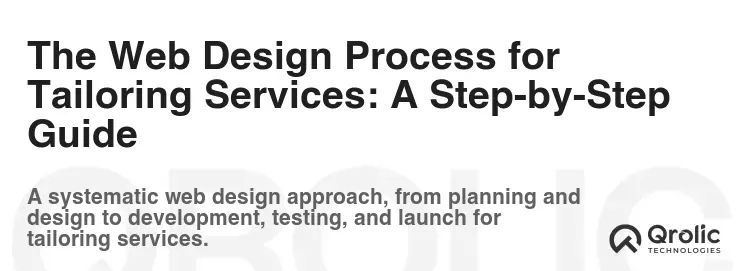
Here’s an overview of the web design process, ensuring you are prepared and informed:
Step 1: Initial Consultation and Planning: Laying the Foundation
- Discuss Your Needs: Share your specific requirements with the web designer, such as the type of website, services to include, design preferences, and target audience.
- Set Goals: Define what you want to achieve with your website, such as increasing local visibility, attracting new clients, or selling products online.
- Budget and Timeline: Agree on a budget and timeline for the project. Ensure these parameters are realistic and achievable.
Step 2: Design and Mock-Ups: Visualizing Your Vision
- Wireframing: The web designer will create wireframes that outline the structure and layout of your website. This helps visualize the user experience.
- Design Mock-Ups: Once the structure is approved, they will create design mock-ups that include color schemes, typography, and image selections.
- Feedback and Revisions: Provide your feedback on the designs and work with the web designer to make any necessary revisions.
Step 3: Development and Testing: Bringing Your Website to Life
- Coding and Development: The web designer will code and develop your website based on the agreed-upon designs.
- Content Integration: They will add content including text, images, and videos to your website.
- Testing and Quality Assurance: Thoroughly test your website on all devices and browsers to ensure everything works correctly and there are no bugs.
Step 4: Launch and Promotion: Making Your Website Go Live
- Website Launch: Once your website is tested and approved, your web designer will launch it, making it accessible to the public.
- SEO Optimization: They will optimize your website for search engines, ensuring it is easily discoverable online.
- Promotion: Promote your website on social media and through other online channels to drive traffic.
Step 5: Maintenance and Support: Keeping Your Website in Shape
- Regular Updates: Ensure your website is kept up to date by applying all necessary software updates and security patches.
- Content Updates: Keep your content fresh by adding new images, text, and promotional offers.
- Technical Support: If issues arise, ensure you have access to technical support to address them swiftly.
Optimizing Your Website for Search Engines: The SEO Stitch
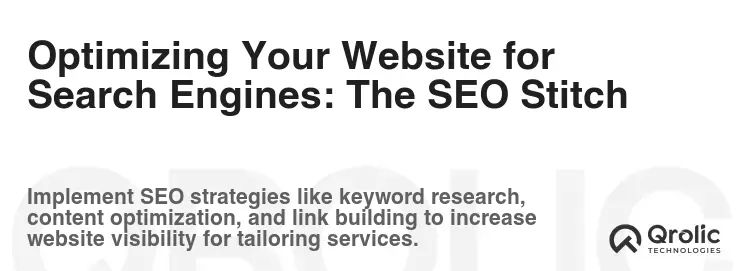
SEO is crucial for ensuring your website ranks well on search engines. Here are some key aspects of SEO optimization:
Keyword Research: Understanding Your Search Terms
- Identify Relevant Keywords: Research the keywords your target customers use when searching for tailoring services. Keywords like “tailoring services near me,” “custom alterations,” and “dressmaking” are relevant.
- Use Keyword Tools: Use keyword research tools to find high-volume and low-competition keywords.
- Incorporate Keywords Strategically: Use these keywords naturally throughout your website content, including page titles, headings, and body text.
On-Page Optimization: Refining Your Website’s Content
- Title Tags and Meta Descriptions: Optimize your page titles and meta descriptions to make them keyword-rich and compelling.
- Heading Tags: Use heading tags (H1, H2, H3) properly to structure your content and highlight important keywords.
- Image Optimization: Optimize your images by using descriptive file names and alt tags. This will help them appear in image search results.
- High-Quality Content: Create informative and engaging content that is valuable to your target audience.
Off-Page Optimization: Building Your Website’s Reputation
- Link Building: Earn high-quality backlinks from other websites in your niche. Link building can improve your website’s authority.
- Social Media Marketing: Promote your website on social media and engage with your followers.
- Local Citations: Ensure your business is listed on local directories and review websites. This improves your local SEO.
Mobile Optimization: Ensuring Your Website’s Accessibility
- Responsive Design: Ensure your website is responsive and adapts to different screen sizes.
- Mobile-Friendly Navigation: Ensure your navigation is easy to use on smaller devices.
- Fast Loading Times: Optimize your website for fast loading speeds on mobile devices.
Analytics and Monitoring: Measuring Your Success
- Track Website Traffic: Use analytics tools to monitor website traffic and user behavior.
- Analyze Key Metrics: Analyze key metrics, such as bounce rate and conversion rate.
- Adjust Your Strategy: Based on the data, adjust your SEO strategy to achieve better results.
Strategies for Finding Affordable Web Designers: The Right Path

Finding an affordable web designer may seem challenging, but here are several strategies to make the process easier:
Freelance Platforms: The Gig Economy
- Browse Portfolios: Look at the portfolios of web designers on freelance platforms.
- Compare Prices: Compare prices and reviews before deciding.
- Project-Based Hiring: Hire web designers for specific projects to manage costs.
Local Web Design Agencies: Local Expertise
- Inquire about Special Offers: Ask local agencies if they offer discounts or special packages for small businesses.
- Negotiate Rates: You may be able to negotiate rates depending on your budget and project requirements.
- Personalized Service: Local agencies can offer more personalized service and support.
Student Designers: Cost-Effective Options
- University or College Programs: Contact local universities or colleges to find web design students looking for projects.
- Lower Rates: Student designers usually charge lower rates than established professionals.
- Fresh Perspectives: Students can provide fresh ideas and innovative designs.
Web Design Software and DIY Options: Doing It Yourself
- Easy-to-Use Platforms: Use DIY web design platforms with drag-and-drop interfaces.
- Templates and Themes: Utilize pre-designed templates and themes.
- Cost-Effective: DIY is the most budget-friendly option if you are comfortable with basic technical tasks.
Referral Programs: Leveraging Your Network
- Ask for Referrals: Ask your network for referrals. This method allows you to find a trusted designer.
- Recommendations: Recommendations from friends or business partners are a valuable source.
- Word-of-Mouth: Word-of-mouth recommendations are often effective in finding quality service providers.
Qrolic Technologies: Your Partner in Digital Excellence

If you’re looking for a reliable and experienced partner to create a website for your tailoring services, consider Qrolic Technologies (https://qrolic.com/). They specialize in providing high-quality and affordable web design and development services.
Why Choose Qrolic Technologies?
- Experienced Professionals: Their team of experienced web designers and developers is equipped to handle various projects and client needs.
- Tailored Solutions: They offer tailored solutions that cater to the specific needs of your tailoring business.
- Affordable Pricing: Qrolic Technologies provides transparent pricing and competitive rates.
- Excellent Customer Service: They prioritize client satisfaction and offer ongoing support.
- SEO Expertise: Their SEO expertise will ensure your website is easily found by customers searching for tailoring services.
- Comprehensive Services: From design and development to SEO and maintenance, they offer a comprehensive range of services.
How Qrolic Technologies Can Help Your Tailoring Business
- Website Design: They can create a visually appealing and user-friendly website that represents your brand.
- E-Commerce Integration: They can integrate e-commerce functionalities, allowing you to sell products online.
- Mobile Optimization: They ensure your website is mobile-friendly and responsive on all devices.
- SEO Services: They can optimize your website for search engines, improving its online visibility.
- Ongoing Support: They offer ongoing support and maintenance to ensure your website runs smoothly.
Qrolic Technologies is committed to helping businesses grow through digital innovation. Contact them today to discuss your website project and take your tailoring service to the next level.
The Future of Web Design for Tailoring Services: Embracing Innovation
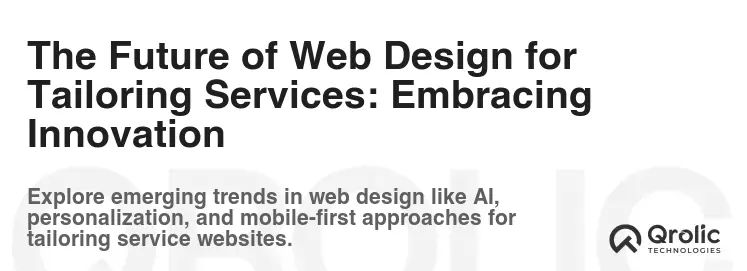
As the digital landscape continues to evolve, so will the way tailoring services use websites. Here are some future trends to consider:
Enhanced User Experience: The Future of Interaction
- Personalized User Experiences: Websites will offer more personalized experiences based on user behavior and preferences.
- Interactive Design: Expect more interactive elements like animations, videos, and virtual tours.
- Seamless Navigation: Websites will focus on making the user experience seamless and intuitive.
AI-Powered Solutions: The Rise of Smart Websites
- AI Chatbots: AI-powered chatbots will assist customers with queries, providing instant support.
- Personalized Recommendations: AI algorithms will analyze customer data and offer personalized recommendations.
- Automated Tasks: AI will automate some tasks like scheduling and appointment management.
Voice Search Optimization: Talking to Your Website
- Optimizing for Voice Search: Websites will be optimized for voice search queries, recognizing the growth in voice assistants.
- Conversational Content: Creating content that caters to conversational search queries will become more important.
- Voice Commerce: Voice-activated shopping will become more commonplace.
Augmented Reality (AR) and Virtual Reality (VR): Immersive Experiences
- Virtual Try-Ons: AR technology will enable customers to try on clothes virtually.
- Virtual Consultations: VR will enable virtual consultations between clients and tailors.
- Immersive Experiences: AR and VR will offer interactive and immersive experiences, enhancing customer engagement.
Conclusion: Stitching Together Your Online Success
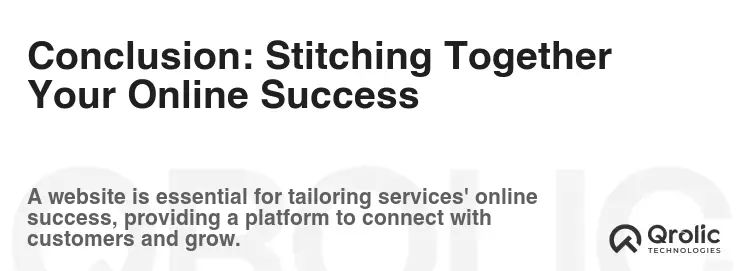
Having a website is no longer optional for tailoring businesses. It’s a critical component of success in today’s digital world. By finding the right web designer, especially one that’s affordable, and focusing on creating a user-friendly, SEO-optimized website, you can expand your customer reach, enhance your brand reputation, and ultimately grow your tailoring service. Don’t delay, start today and stitch together your online success story. Remember that a strong online presence is an investment that will provide lasting returns for your business. Consider Qrolic Technologies as your web design partner and embark on your digital journey with confidence.






